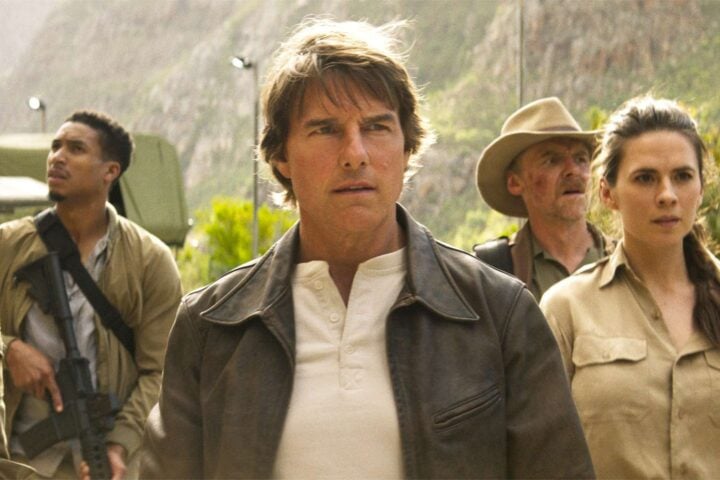Christopher McQuarrie’s Mission: Impossible – Dead Reckoning Part One too often gets bogged down in plot mechanics in the lead-up to the showdown between Ethan Hunt (Tom Cruise) and renegade assassin Gabriel (Esai Morales) for control over an all-powerful A.I. system called the Entity. Luckily, Mission: Impossible – The Final Reckoning, takes advantage of its predecessor’s lugubrious narrative by hitting the ground running.
The first 20 minutes of the film, written by McQuarrie and Erik Jendresen, effectively lay out just how much control the Entity has gained over the world’s computer systems and driven mankind to the brink of total war. This allows for the rest of Final Reckoning to proceed as a showcase for preposterous (and mostly practical) action and an unabashed sentimentality that Ethan feels for the makeshift family of spies he’s assembled over the course of the series.
It’s the latter, in fact, that provides most of the narrative momentum here. Both the Entity and Gabriel reveal just how many of Ethan’s actions over the years to defend his loved ones have led to this moment, and the means by which they hope to manipulate him into triggering the nuclear holocaust that the Entity sees as a means of resetting the world in its own image of efficiency and control. With those basics established, Final Reckoning quickly sets about building the most elaborate action sequences yet in a series defined by excess.
Dead Reckoning’s major action scenes, as well-executed as they are, at times feel too much like throwbacks to set pieces from earlier Mission: Impossible films. With Final Reckoning, though, McQuarrie really lets his imagination loose with some fresh, dizzyingly complex showcases for Ethan’s ability to do anything no matter how outlandish the context.
An attempt to retrieve the Entity’s source code from a sunken Russian sub starts wildly enough with a multi-pronged effort to locate and reach the vessel, at which point Ethan’s every movement within the ship causes it to shift more and more on the unstable outcropping on which it rests. This constantly upends the axis of orientation of the physical set, and more clutter and water keep radically altering Ethan’s path forward and, more worryingly, the way back out.

Almost an extension of these kinetically staged sequences, scenes of explanatory dialogue are made propulsive thanks to cross-cutting between Ethan and various members of his team laying out each wildly implausible, perfectly timed step of their plan. Later, that same approach helps link actions between various pockets of characters as separate attacks on Ethan and his crew are brilliantly bridged by match cuts of close-quarters strikes and gunfire.
At times, McQuarrie even makes shrewd work of implication, as in an early brawl that occurs almost entirely off-camera as Ethan turns implements on his would-be torturers, with nothing more than the increasingly wet sound effects of blunt force trauma and the horrified facial expressions of Ethan’s love interest, former thief turned IMF agent Grace (Hayley Atwell), to convey the brutality. Despite running a half-hour longer than the previous film, Final Reckoning feels significantly shorter thanks to this steady grasp of pace.
Most surprising about these set pieces is the extent to which they lean into something that’s rarely acknowledged about the Mission: Impossible films: the absurdism that underlies the franchise’s appetite for escalation. The submarine sequence is a nonstop series of one damn thing after another—a thrilling vision of an already byzantine plan being screwed up at every turn by the ever-shifting vessel and the clutter that keeps sealing off Ethan’s potential exits.
Elsewhere, a climactic chase in the skies involving biplanes practically enters Looney Tunes terrain in the way the tension of a winnowing countdown to doom is punctured by a brief, almost cathartic sight gag. As if compensating for Gabriel’s shallow depth of characterization, the filmmakers essentially position Cruise’s Ethan as the Tom to Morales’s Jerry, each subjecting the other to carnage so outrageous that it can’t help but elicit your laughter.
This is a bold tonal pivot to introduce at the putative finale of a 30-year-old film series, which is all the more remarkable for the fact that Final Reckoning is the most nakedly sentimental of the Mission: Impossible movies. Embracing Dead Reckoning’s clear moral stakes of coldly perfect artificial intelligence sapping the world of all meaning, Final Reckoning positions Ethan’s outrageous, unpredictable schemes and deep love for others as the ultimate form of resistance to the cold, merciless programming of the Entity. It’s precisely Ethan’s willingness to risk the world to save one person in his makeshift family that constantly allows him to beat the odds, and if the 62-year-old Cruise continues this series, as he’s hinted he might, it would be a fitting tribute to the character’s refusal to accept the futility of fighting against inevitable failure.
Since 2001, we've brought you uncompromising, candid takes on the world of film, music, television, video games, theater, and more. Independently owned and operated publications like Slant have been hit hard in recent years, but we’re committed to keeping our content free and accessible—meaning no paywalls or fees.
If you like what we do, please consider subscribing to our Patreon or making a donation.





